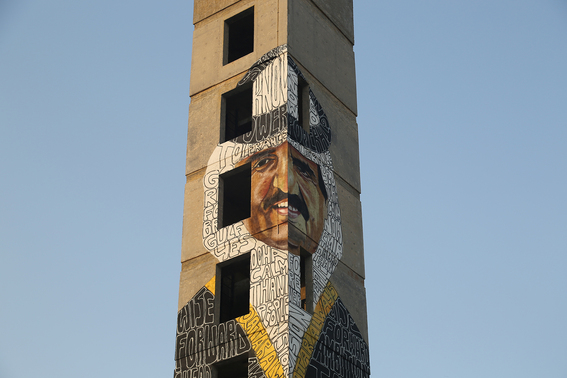
R
E
V N
E
X
T
Qatari Artists Commissioned To Create Murals As Protest Against Embargo
Five artists in Qatar have covered the facade and other surfaces of Doha’s Fire Station art space with murals, as a protest against the blockade of Qatar by Saudi Arabia, the United Arab Emirates, Bahrain and Egypt. Murals by Mubarak al-Malik, Ali al-Kuwari, Dimitrije Bugarski, Thamer Mesfer and Assil Diab were unveiled at Fire Station on September 12 as the first step of the “100 Days of Blockade” initiative, which provides a platform for Qatar-based artists to respond to the ongoing dispute.
Bugarski’s contribution is a split portrait of Qatar’s current and former emirs, which was painted on the former fire training tower in the courtyard of Fire Station. Al-Malik’s massive clenched fist smashing through barbed wire is on the art space’s facade.
On June 5, Saudi Arabia and its allies placed a trade and diplomatic embargo on Qatar, alleging that the oil-rich country’s monarchs have sponsored terrorist organizations across the Middle East for decades. The blockade was partly triggered by a news report published on the website of state-run Qatar News Agency, in which the emir of Qatar, Sheikh Tamim bin Hamad al-Thani, was quoted praising Israel and Iran, and criticizng US President Donald J. Trump’s foreign policy toward Tehran. (The Qatari government quickly said that the report was put online by hackers.) Shortly after, Saudi Arabia, the UAE, Yemen, Egypt, Bahrain, the Maldives, Mauritania, Comoros, Chad, Libya’s eastern-based government and the self-declared Somaliland cut diplomatic relations with Qatar.
Saudi Arabia and some of its allies have also demanded that Qatar shut down its state-funded broadcaster Al Jazeera and cut back ties with Tehran.
The initiative’s next phase involves placing murals on the surfaces of a “bridge, tunnel or wall.” Proposals from artists will be judged by members of Fire Station and the Public Works Authority of Qatar.
Helena Halim is an editorial intern at ArtAsiaPacific.
To read more of ArtAsiaPacific’s articles, visit our Digital Library.



